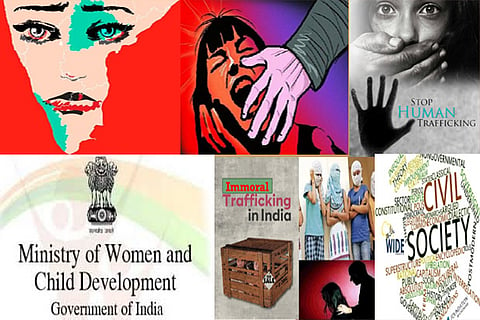

Chennai
The child who was repeatedly assaulted by as many as 10 men every day, was ‘managed’ by different brokers who earned lakhs by putting her up to this job. Eight persons have been arrested in connection with this case. But the incident is just one of the many instances of trafficking, carried out across the state.
Just last week, a 16-year-old, the daughter of a daily wage earner in Madurantakam, was kidnapped by a three-member team who forced her into the trade. Following the father’s complaint, the police rescued the minor from Madurai. Similarly, last month, Kanathur police raided two resorts in Panaiyur and Kovalam, rescued eight women and arrested six men running a prostitution racket. Here, it was the resort owner who brought the women into the city with the promise of jobs and later pushed them into commercial sex work.
In various districts of Tamil Nadu, trafficking of women has turned into a major spinner of illicit gains. In August, 19 pimps were arrested in Thanjavur, while their victims, nine women were rescued from houses masquerading as massage parlours. The developments are a cause for concern as law enforcement veterans have cited a surge in the number of minors being pushed into such syndicates.
The Union Ministry of Women and Child Development recently came out with a study called Commercial Sexual Exploitation in India, which pegged the number of sex workers in India to 3 mn. Out of these, 35.47% had entered the trade before they turned 18. The report offered damning statistics on the number of minors involved in such work - 1.2 mn children. Also, between 1997 and 2004, a 50 per cent spike in prostitution was reported in India.
Tamil Nadu’s reputation as a hub of human trafficking was cemented five years ago when the state reported the third-highest number of incidents of human trafficking with 577 cases in 2015. The year witnessed 511 cases registered under provisions of the Immoral Traffic (Prevention) Act, of which 351 were filed under Section 5, pertaining to procuring, inducing and pushing a person into prostitution.
The numbers paint a tragic picture and there are no easy answers in matters concerning the world’s oldest profession. Members of civil society and NGOs present arguments for the legalisation of the trade, and creation of a legal framework that would recognise the rights of commercial sex workers and protect minors from exploitation. But regulation might be a far cry for a profession that has little to do with consensual employment. In Anantapur district in Andhra Pradesh, there are women from tribal communities living in slums, who have been ravaged by decades of drought and economically crippled by the ban on arrack. These ladies have taken to commercial sex work to make ends meet. It is one of the reminders that a very minuscule percentage of people enter the profession by choice.
So where does the conversation regarding such a problem begin? In 2010, about 76 children from Assam and Manipur, were rescued from ‘homes’ operated by missionaries in TN. Taking cognisance of this incident, the Supreme Court that year, passed an order which banned sending out children below the age of 12 years or those in primary schools to other states to pursue education. A decade since, trafficking continues unabated. Stronger punishments and imprisonment aren’t the sole solutions. The absence of a financial and social safety net that pushes millions towards penury, is one of the factors that need redressal. There is also a need for open, objective-centric discussion in civil society, on how commercial sex workers must be accounted for in the national scheme of things. Treating the issue as a taboo subject matter is not an option any longer.
Visit news.dtnext.in to explore our interactive epaper!
Download the DT Next app for more exciting features!
Click here for iOS
Click here for Android